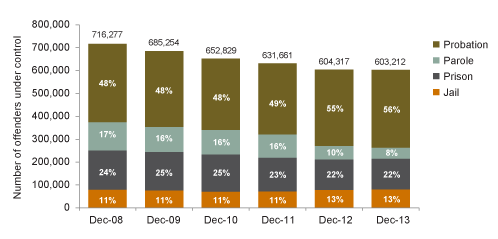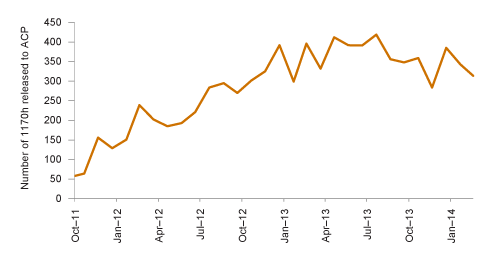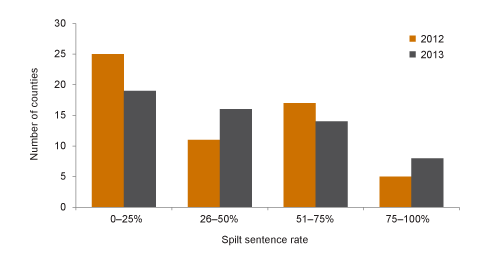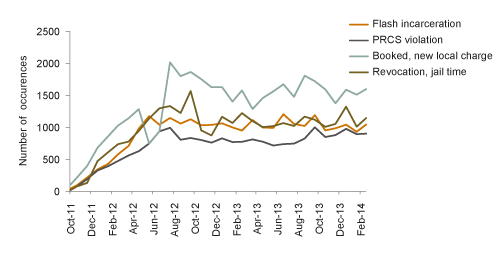Summary
Three-plus years after implementing a major realignment of its public safety systems, California continues to face pressure to reduce both its prison and jail populations. California relied on some alternatives to custody-based punishment before realignment but it has been expanding its use of others. Current research on the effects of incarceration and its alternatives offers a general endorsement of the idea that increasing reliance on community-based alternatives is not likely to result in large increases in crime and recidivism. The evidence suggests that the effectiveness of both incarceration and community-based supervision depends on a number of factors, including the rate of incarceration in a given community, the offender characteristics, and the nature of the response to violations during and after supervision. Finally, intensive data collection on county implementation efforts can help the state identify the community-based strategies that produce the best outcomes.
California’s Changing Corrections Landscape
California is under pressure to adopt and expand alternatives to custody-based punishment-commonly called incarceration-that can hold offenders accountable, are cost-effective, and do not have negative effects on public safety. Perhaps the most immediate impetus for change was a 2009 federal court order to address overcrowding by reducing the state prison population to 137.5 percent of design capacity by 2016. The state responded by implementing public safety realignment in 2011, and since then county jail populations have increased.1 A second major factor is the high cost of locking people up. Prisons and jails are eating up an increasingly large share of state and local criminal justice resources and an increasingly large share of the state budget. In 1970, corrections made up only 3 percent of the state’s General Fund budget; in 2014-15, it makes up more than 9 percent. Costs per inmate are among the highest in the nation.2 In 2012, the per capita cost to incarcerate an offender in the state prison system was $58,816; a county jail inmate on average, cost about $41,563 per year.3 Finally, there has been a general nationwide mood shift on incarceration, amid reevaluations of its effectiveness. In California, this shift was reflected last November in the passage of Proposition 47, which converted some drug and property offenses from felonies to misdemeanors. Initiatives like Smart on Crime and Justice Reinvestment that move away from “get tough” policies of previous decades have also stimulated interest in lessening reliance on incarceration in California.4
As Figure 1 shows, the overall number of individuals under correctional supervision has decreased in recent years.5 Although the shares of offenders in prison or jail versus parole or probation are unchanged, there has been a substantial increase in the percentage of offenders managed by the counties. These shifts have led many to consider how the state and its counties can make the best use of the scarcest and most expensive resource in the system: a jail or prison bed.
Figure 1. California’s correctional population is declining

SOURCES: California Department of Justice: Criminal Justice Profile, California Department of Corrections and Rehabilitation: Prison and Parole Monthly Population Reports, Board of State and Community Corrections: Jail Profile Survey, Chief Probation Officers of California: Realignment Dashboard.
NOTES: For years after 2010, we take into account realignment populations now under the control of probation. We combine the California Department of Justice’s probation counts with counts of mandatory supervision and post-release community supervision population from Chief Probation Officers of California realignment dashboard.
In the report we look at the alternatives to incarceration currently in use in California. We are able to look most closely at the alternatives that have been expanded in the wake of realignment. We then examine recent research on strategies that can help the state lower its use of incarceration (and its costs) without experiencing worse outcomes in terms of crime and recidivism.
Alternative Custody Programs in Use
We define alternatives to incarceration as punishment or treatment responses to offenders that involve something other than confinement in a secure facility (i.e., prison or jail), either at the point of sentencing or in response to noncompliant behavior of an offender already under community supervision. These include placement in a non-custodial setting during a term of punishment (e.g., split sentence, work release, home detention, electronic monitoring, earned discharge, medical release), probation, supervision by a specialty court in lieu of custody, community service, placement in a half-way or sober-living house, fines, and mandatory treatment or training. Alternatives can be established as a matter of law and policy; they can also result from offender initiative (e.g., offenders can apply for out-of-custody placements), or from discretionary decisions (e.g., early release to electronic monitoring program, referral to treatment in lieu of revocation).
State and County Programs
At the state level, alternatives to custody are limited. The California Department of Corrections and Rehabilitation (CDCR) offers just a few programs that allow a small number of female CDCR inmates to serve sentences in a community-based facility.6 Other than that, CDCR does not place male or female inmates who have been sentenced to state prison in non-custodial settings. However, in response to parole violations, they may use alternatives such as home detention, electronic monitoring, or sober-living housing. In 2008, CDCR’s Division of Adult Parole adopted a “parole violation decision-making instrument” (PVDMI) intended to reserve returns to prison for the highest-risk parolees and the most serious parole violations, with other parole violators placed into alternative programs.7 However, an early evaluation of the PVDMI suggested that the instrument was seldom used.8 Realignment shifted authority for sanctioning decisions for parole revocations to county courts and the PVDMI no longer serves as a guide.
Counties appear to use a greater range of alternatives. Each county board of supervisors can authorize county correctional administrators to operate voluntary and involuntary alternative custody programs (ACP). Two of the most common programs, specifically mentioned in state law, are home detention and work release.9 Home detention programs require offenders to serve sentences in specific residential locations. Most home detention programs require participants to be monitored by electronic or GPS devices. Counties can develop their own program rules and criteria, including charging application and daily fees.
Counties also run work release programs that allow offenders sentenced to county jail to spend time on community service projects, including picking up roadside trash and repairing public buildings. Program participants receive one day of sentence credit for every day (8 to 10 hours) served in a work program. As with home detention, each county develops its own rules and criteria for participation in the program, including application and daily fees.
Currently available data do not allow for an in-depth analysis of all custodial alternatives across the state. However, California counties included in yearly U.S. Bureau of Justice Statistics (BJS) surveys between 2003 and 2012 had substantial shares-ranging from 11 to 18 percent-of individuals under their control who were not confined in jail facilities.10 Realignment has further motivated counties to expand existing alternative custody programs and authorized the use of two new tools to lessen the pressure on county jails: split sentencing and flash incarceration.11 We can look more closely at the use of these new tools using data that has been collected and made available by state agencies.
Alternative Custody Programs Have Expanded since Realignment
County alternative custody programs can now include newly realigned offenders-non-serious, non-violent, non-sexual (1170h) felons who previously were eligible for prison but now serve all or part of their sentences in county jail.12 Counties now have the option of placing these 1170h offenders in work release programs, home detention, or electronic monitoring programs at any point during their sentences. Offenders serving local sentences have been eligible for placement in alternative custody programs for years.
As Figure 2 shows, alternative custody placements for realigned offenders have increased but are being used for a low number of 1170h inmates. A majority of counties have reported placing at least one realigned individual in an alternative program in both 2012 and 2013, but five counties accounted for 71 and 68 percent of the total placements, respectively, in those years.13
Figure 2. Statewide use of alternatives to custody for realigned offenders is increasing but still at a low level

Split Sentences. Under realignment, judges can impose split sentences-county jail terms followed by mandatory supervision in the community. In addition to structuring and supervising offenders’ reentry to the community by allowing for rehabilitation to start during the offenders jail term and continue while in the community, split sentencing is designed to decrease pressure on jail and prison space. The judge has full discretion in splitting a sentence between incarceration and community supervision phases.
Figure 3. Split sentencing is uneven across counties

SOURCE: Chief Probation Officers of California (CPOC) Realignment Dashboard.
NOTE: Alameda and Sacramento County are omitted from the 2013 analysis because CPOC did not report full 2013 information for these counties at the time of author’s analysis.
There was an overall increase in the use of split sentencing between 2012 and 2013, but it varied significantly across the state. Usage should continue to increase now that state law-as of January 1, 2015-makes a split sentence the default for realigned offenders.14 Counties such as Contra Costa, Riverside, San Benito, San Joaquin, and Stanislaus have split sentencing rates above 75 percent. However, a majority of counties have split sentencing rates below 50 percent (Figure 3). Statewide, the split sentencing rate increased from 27 percent in 2012 to 32 percent in 2013. However, the statewide rate in 2012 and 2013 is strongly affected by the low usage rate in Los Angeles County (3.64% and 1.43%, respectively).15 With Los Angeles omitted from the calculation, the statewide rate is 35 percent in 2012 and 43 percent in 2013.
Flash incarceration. Flash incarceration, another tool introduced by realignment, gives county probation departments an intermediate sanction for individuals on post-release community supervision (PRCS) or mandatory supervision. Instead of revoking supervision or charging violators with new crimes, a department can sentence them to county or city jail for a short period, ranging from one to ten days. Flash incarceration is designed to allow counties to respond quickly to violations without the disruption to offender reentry caused by long sentences; it has the added benefit of minimizing the impact on custodial resources. Counties are using flash incarceration, but if they are now using flashes for actions that were not sanctioned before realignment, then flash incarceration may not actually be decreasing reliance on incarceration. The statewide data show that new local charges are more common than flash incarceration or PRCS violations.
Figure 4. The most common county response to supervision violations is to file new local charges

Key Findings on Incarceration and Alternatives
While much of the impetus to find effective alternatives to incarceration is linked to overcrowding and costs, there are also many questions about the extent to which putting offenders in prison or jail reduces crime. We now briefly consider what existing research indicates about the effectiveness of both incarceration and its alternatives. It is important to recognize that this work poses a range of questions and relies on a wide variety of data, methods of analysis, definitions of key outcomes, and offender populations. As is the case in most policy research, there remain areas of disagreement and topics yet to be examined. Here we focus on three overarching questions. Interested readers can consult the Technical Appendix for further details.
Does Incarceration Reduce Crime?
One of the presumed functions of incarceration is to deter or incapacitate offenders and, as a result, to reduce crime. There is substantial evidence that suggests that increases in the use of imprisonment decrease crime, although there is quite a bit of disagreement about whether the effects are large or small. The most recent and convincing estimates suggest that a one-person increase in the incarceration rate results in a decrease of .2 to .3 reported incidents of violent crime per 100,000 residents, and a decrease of 2.9 to 3.4 in reported property crimes per 100,000.16 However, there is also compelling evidence that the size of the effect depends heavily on the rate of incarceration. In other words, places like California that already incarcerate offenders at a high rate (400 per 100,000) appear to achieve less crime reduction from placing offenders in custody than systems with low incarceration rates.17 Moreover, there is strong evidence that it is not so much the severity of punishment, measured by sentence length, as the certainty of punishment that is most important in deterring crime. Finally, there are a handful of studies that show that the costs of incarceration are high relative to the resulting reduction in crime.18
Several policy implications follow from the research summarized above (and examined in more detail in the Technical Appendix). First, a modest decrease in reliance on custody, especially in systems with extremely high rates of incarceration, will probably have little or no effect on crime. Second, lengthy sentences cannot be justified as crime deterrents; conversely, shorter sentences can be cost-effective, even if crime goes up a bit. Third, it might be more cost-effective to focus on policing, probation, and parole system strategies that increase the certainty of punishment. Finally, the incarceration of low-frequency offenders is not a cost-effective approach to reducing crime; a more effective crime reduction strategy is to incarcerate high-frequency offenders.
Is Incarceration More Effective than Community-based Supervision in Reducing Recidivism?
Would relying less heavily on incarceration have an effect on recidivism? Studies generally find little to no difference in recidivism when comparing outcomes for incarcerated offenders with offenders sentenced to the community. A few studies show better outcomes for individuals placed in custody, but the effects are surprisingly small. Several studies show worse recidivism outcomes for incarcerated offenders, although this does not emerge as clearly in studies that make extensive adjustments for different groups of offenders.19 This holds true in recent research that factors the length of incarceration into the calculation of recidivism, which suggests that incarceration may be less beneficial than we might assume.
Given that custodial placements are substantially more expensive than placements in the community, the implication is that widening the use of community-based punishments can conserve resources without necessarily worsening recidivism.
Which Incarceration Alternatives Are Most Effective?
Research that addresses the question of what we should be doing with offenders in the community can inform discussions about alternatives to incarceration in California. Two strategies in particular are supported by large bodies of research: intensive supervision combined with swift responses to violations and services tailored to address the needs of high-risk offenders.
Intensive Supervision and Swift Response. One community-based strategy is to place offenders who might have gone to prison or jail under intensive supervision. This kind of approach’sometimes referred to as “surveillance-focused” or “control-based”20 and the project was part of the inspiration for California’s policy of “flash incarceration, which involves placing noncompliant offenders in jail for up to ten days instead of seeking to revoke parole and send offenders to jail for a longer period.21
Targeted Services. A large body of research has been conducted on a range of services intended to reduce recidivism: educational, employment, anger management, substance abuse, mental health, and cognitive behavioral therapy programs, to mention a few.22 Evidence suggests that services that are rooted in a broader theory known as the “Risk, Need, Responsivity” (RNR) framework are especially effective. This subset of programs relies on actuarial risk and needs instruments to target interventions at offenders at the highest risk of reoffending and focus specifically on addressing assessed “criminogenic needs.” The intervention must be responsive to an offender’s learning style, motivations, and strengths. These programs also seem to work well in probation and parole systems whose staff embraced a “human services’ over a “deterrence” approach.23
Effective Implementation. Surveillance and service are overarching design principles for community-based supervision programs, policies, and interventions. But it is important to bear in mind that not all strategies based on these principles are effective. The effectiveness of surveillance depends on the response to noncompliant behavior once it is detected, and the most promising response involves swift, certain, and short-term custodial sanctions. Likewise, services that are attentive to risks, needs, and responsivity appear to achieve better results than those delivered outside the RNR framework.
Moreover, these two principles are not mutually exclusive. There is evidence that the most promising approach is to combine elements of surveillance and services. Finally, it is important to recognize that even if community-based programs do no better than incarceration, or even slightly worse, they may still be more cost-effective.
Can We Do More?
A key policy question is whether alternatives to incarceration in California can be expanded. Research suggests that California may be able to scale back its use of custody-based punishment by turning to carefully constructed policies and programs that (a) employ community-based alternatives for low-risk offenders for all or a portion of their sentences; (b) use swift and certain sanctions as a deterrent to noncompliance among those offenders; and (c) provide services based on risk, need, and responsivity.
The challenge lies in implementing these programs effectively. At present, we have only a superficial understanding of the community-based strategies being adopted by counties. In order to find out whether counties’ implementation efforts are living up to their aspirations to implement evidence-based policies, the state needs to build a more robust infrastructure for data collection. Policymakers and researchers can leverage a key feature of the California community corrections system, which encourages counties to try innovative strategies for managing offenders. This requires that county correctional agencies be willing and able to participate in experimental and quasi-experimental research. It requires data on services, sanctions, and supervision to be linked to data on offender backgrounds, demographics, and recidivism outcomes. Currently, intensive data collection could be undertaken in some counties and on specific types of programs, but most counties lack the capacity to capture these minimal elements.24
PPIC is collaborating with the Board of State and Community Corrections to create a model for precisely this kind of effort in 11 representative counties across California. The data generated by this project will be an initial step toward identifying effective strategies that improve offender outcomes and enhance public safety.
A technical appendix is available on ppic.org.
Topics
Criminal Justice

